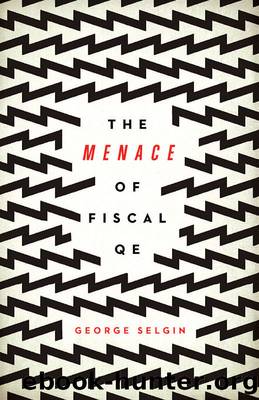The Menace of Fiscal QE by George Selgin

Author:George Selgin [Selgin, George]
Language: eng
Format: epub
Publisher: Cato Institute
Published: 2020-02-10T23:00:00+00:00
QE and Backdoor Spending
The other reason for fiscal QEâs political appeal is its ability to support âbackdoor spending,â meaning federal agency spending that bypasses the annual congressional appropriations process.4 Even before the Fed acquired its present quantitative easing powers, it was understood to be capable of facilitating backdoor spending. J. Alfred Broaddus, Jr., and Marvin Goodfriend (2001, 13) write:
A healthy democracy requires full public disclosure and discussion of the expenditure of public funds. The congressional appropriations process enables Congress to evaluate competing budgetary programs and to establish priorities for the allocation of public resources. Hence the Fedâprecisely because it is exempted from the appropriations processâshould avoid, to the fullest extent possible, taking actions that can properly be regarded as within the province of fiscal policy and the fiscal authorities.
Thanks to its post-2008 QE powers, the Fedâs ability to encroach upon âthe province of fiscal policy,â and thereby fund government undertakings independently of the congressional appropriations process, is now far greater than it was when Broaddus and Goodfriend wrote.
Substantive legislation might, for example, create a new program to be carried out by either an existing or a new agency, while also granting that agency âborrowing authorityâ for the purpose of funding the program. Borrowing authority normally allows agencies to sell securities either to the Treasury or directly to the public. But if granted in conjunction with a fiscal QE plan, it could instead mean having agencies sell securities to the Fed.5 As Modern Monetary Theorists Scott Fullwiler and Randall Wray (2010, 20) explain, when agencies borrow from the Fed rather than the Treasury, the appropriations process is all the more thoroughly bypassed: whereas Treasury lending must itself be approved by Congress, âthe Fed does not face such a budgetary constraintâit can commit Uncle Sam to trillions of dollars of commitments without going to Congress.â Furthermore, agency borrowing isnât itself subject to statutory debt limits.6
Backdoor spending appeals to advocates of large-scale, ongoing spending programs that would otherwise be difficult to fund initially and more vulnerable to future funding interruptions. In a compelling critique of backdoor spending from a constitutional perspective, Kate Stith (1988, 1381) explains that fiscal illusion comes into play here as well:
Of course, the true (âopportunityâ) cost of any permanent, indefinite, or backdoor spending authority is no different from the cost of an annual appropriation. But . . . Congress may operate (as a matter of policy or of psychology) under the illusion that funding for the activity does not affect other budgetary decisions, and that the present Congress is neither responsible nor accountable for the program.
What backdoor spending certainly does is make it less likely that Congress will effectively control government spending. To the extent that the executive branch can bypass the appropriations process, Stith observes, it alone
defines the scope and character of the public sphere, especially in areas that inherently require significant executive discretion. Congress abdicates, rather than exercises, its power of the purse if it creates permanent or other open-ended spending authority that effectively escapes periodic legislative review and limitation.
Download
This site does not store any files on its server. We only index and link to content provided by other sites. Please contact the content providers to delete copyright contents if any and email us, we'll remove relevant links or contents immediately.
International Integration of the Brazilian Economy by Elias C. Grivoyannis(85467)
The Radium Girls by Kate Moore(11862)
Turbulence by E. J. Noyes(7891)
Nudge - Improving Decisions about Health, Wealth, and Happiness by Thaler Sunstein(7454)
The Black Swan by Nassim Nicholas Taleb(6941)
Rich Dad Poor Dad by Robert T. Kiyosaki(6310)
Pioneering Portfolio Management by David F. Swensen(6167)
Man-made Catastrophes and Risk Information Concealment by Dmitry Chernov & Didier Sornette(5873)
Zero to One by Peter Thiel(5632)
Secrecy World by Jake Bernstein(4591)
Millionaire: The Philanderer, Gambler, and Duelist Who Invented Modern Finance by Janet Gleeson(4288)
Skin in the Game by Nassim Nicholas Taleb(4121)
The Age of Surveillance Capitalism by Shoshana Zuboff(4115)
The Money Culture by Michael Lewis(4020)
Bullshit Jobs by David Graeber(3988)
Skin in the Game: Hidden Asymmetries in Daily Life by Nassim Nicholas Taleb(3866)
The Dhandho Investor by Mohnish Pabrai(3632)
The Wisdom of Finance by Mihir Desai(3602)
Blockchain Basics by Daniel Drescher(3427)
